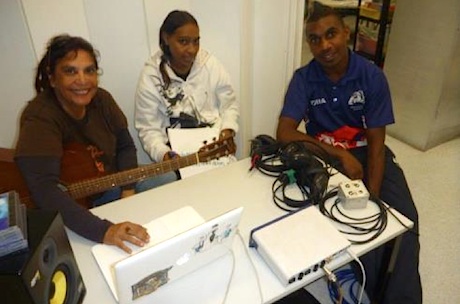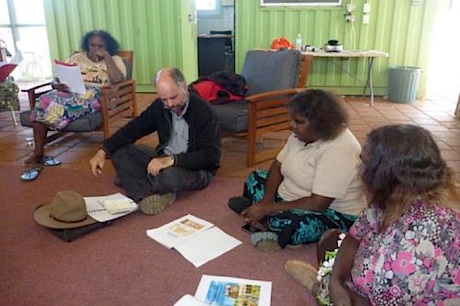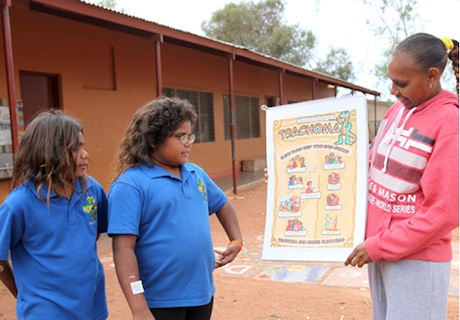Trachoma is a severely painful disease and the largest infectious cause of blindness in the world. Australia remains the only developed country where trachoma still exists.
This project aims to eliminate trachoma in Indigenous communities through a treatment strategy called S.A.F.E: Surgery, Antibiotics, Face washing, Environment.
The S.A.F.E. strategy has proven to be successful in eradicating trachoma in a number of developing countries. It is now being implemented in remote Australia, with the aim of eliminating trachoma by 2020, or sooner.
Project activities
- Employ Community Based Workers (CBWs) to conduct screenings and treatments and engage with the community in a culturally appropriate way.
- Create health promotion initiatives matched to community needs (such as music workshops and story books in local Indigenous languages) to deliver key health messages.
Music Workshops - an effective way of engaging children in remote communities.

Photo: Shellie Morris rehearsing the Trachoma song with Ntaria CBWs Thelma Moketarinja and Mathew Moketarinja.
Shellie Morris, a highly respected Indigenous musician, a Fred Hollows Foundation Ambassador and nominee for NT Australian of the Year worked with children in these communities to write, perform and record a song containing trachoma prevention messages.
Community based workers (CBWs) collaborated with Shellie to tailor the workshops to meet their communities’ requirements. This was particularly successful in Ntaria (also known as Hermannsburg), where the two CBWs are very competent musicians. This process is equally as important as the end product, as important messages are absorbed improving the take up and maintenance of prevention behaviours.
The final result of each workshop was a recorded song and video, both of which have been played regularly by local media in every participating community.
Ti Tree Trachoma book - health messages in local languages

Photo: From L to R: Hazel Presley (CBW), David Moore (Linguist from Batchelor Institute), Doreena Stirling (CBW) and Kathleen Mbit- jana (Woman Elder) of Ti Tree Community, checking the spelling and writing of the languages being used in the Ti Tree Trachoma Book
The Ti Tree Trachoma Book is an illustrated story about how to prevent and treat trachoma, and is designed for school aged children. It is an excellent example of community led and grounded health promotion.
Fiona Stokes, The Foundation’s Community Based Worker Coordinator, convened a group of elders from both locations to design and develop the book. Over several sessions, this group wrote the story in three languages – English, Anmatjere and Warlpiri – and also produced illustrations for each page. The two trachoma CBWs were important contributors and facilitators of the process, with one being the principal author.
As a result of the success of the process, and the positive feedback received from both community members and trachoma program partners, it is planned to develop trachoma books in other targeted communities in 2014.
Amplifying health messages through partnerships, media and events
Involvement by CBWs in local media is extremely valuable as community radio stations are very popular in remote Australia and messages about screenings and hygiene delivered by local community members have a high impact.
In 2013, a range of community and sporting event days were used to promote Trachoma elimination, included Community Health Days, Opening Days, and community barbecues.
The Fred Hollows Foundation also participated in a trachoma hygiene station at an AFL Clinic conducted in Tennant Creek by players from the Melbourne Football Club, which is a partner in the national trachoma program. Children from Tennant Creek and some remote Barkly region communities attended the clinic, which involved a combination of football skills stations and trachoma hygiene stations.
Case Study - Meet Thelma, an Aboriginal Community Based Worker

Photo: Thelma teaching students about trachoma.
Meet Thelma, 23, a mother of two who is helping eliminate trachoma in the community of Ntaria (Hermannsburg) as a Foundation-supported Aboriginal Community Based Worker.
Thelma now plays a critical role in educating her community about trachoma and encouraging good eye health habits.
Thelma connects people in the Ntaria community with eye nurses and other health workers who can provide trachoma treatment. She is able to educate people on eye health in a culturally appropriate way. Strategies include having eye health materials approved by community elders and translated into their Arrernte language to ensure local understandings of trachoma and how to prevent the disease.
The knowledge Thelma shares is leading to behavioural change in her community, which is the key to preventing trachoma reinfection in the future.
Reaching children is a priority. During a recent mass trachoma treatment and screening at the local school, Thelma worked with nurses to explain the purpose of trachoma antibiotics and teach positive eye health messages.
“I teach the kids to wash their hands and nose and keep their faces clean so they have good eyes and don’t go blind when they get older," says Thelma.
“I like to help the kids and the young ones so when they grow up they can help their own children,” Thelma says.
Thelma feels positive about the future eye health of people in her community. One day she would like to train as a nurse so she can do even more to help children.
“I’m hoping my two girls do as I’m doing now when they grow up – finish school and work in the community,” she says.
Brendan Johnson, Public Health Nurse, Northern Territory Government Centre for Disease Control, Trachoma Program says:
“Without [the Community Based Workers] we would be ineffective – they make a major difference to the efficacy of the whole trachoma treatment week...as does the staff from a number of community organisations...After such a positive experience, we are advocating strongly for Community Based workers to be employed at other communities in the Top End of the NT” and “The CBWs played an integral part of the Trachoma Treatment team, contributing highly to the success of the week. Without their help and knowledge the project wouldn’t have achieved the results that it did’
What's next?
Footprints is continuing to provide funds though out 2014 for this large scale Trachoma Elimination project to increase the number of Indigenous Australians being screened and treated for trachoma.
The project aim:
To eliminate trachoma in 10 Indigenous communities in the Northern Territory.
Project objectives
- Increase the number of Indigenous Australians being screened and treated for trachoma
- Expand the support offered to community-based workers to take part in implementing components of SAFE programs
- Expand community awareness and implementation of good hygiene practices
- Continue to work with government to ensure environmental improvements are made where necessary in affected communities, to ensure the sustainability of SAFE strategies
This major project runs over several years. This is the second year that Footprints has provided funding to help The Fred Hollows Foundation meet this ambitious goal. (See the initial project)
Background on this issue:
Trachoma is a highly infectious, severely painful disease. It is the largest infectious cause of blindness in the world with around 4.6 million people in advanced stages of the disease. Over time a person’s eyelids
become scarred and the eyelashes turn inwards, rubbing on the cornea and ultimately causing blindness (called Trichiasis).
There is good news however – it is preventable and treatable. The Fred Hollows Foundation works to
eliminate trachoma through a World Health Organisation treatment strategy called S.A.F.E: Surgery, Antibiotics, Face washing, Environment.
Trachoma in Indigenous Australia
Australia is the only developed country in the world where trachoma remains active. There is still more work to be done to eliminate this disease in Australia for good. It is still present in two thirds of remote communities in the Northern Territory, Western Australia and South Australia.
According to a 2009 National Indigenous Eye Health Survey report, there are 80 Aboriginal communities where more than 5% of Aboriginal and Torres Strait Islander children have active trachoma, the rate considered by the World Health Organisation to be of public health importance. In some communities that figure is as high as 14%.
The survey also showed that 4% of adults aged 40 and over living in the communities surveyed are affected by trichiasis.

Project partners
Developed
in collaboration with the Northern Territory Government’s Centre for Disease Control and the University of Melbourne Indigenous Eye Health Unit, the program will be implemented in partnership with these agencies and managed by The Fred Hollows Foundation.